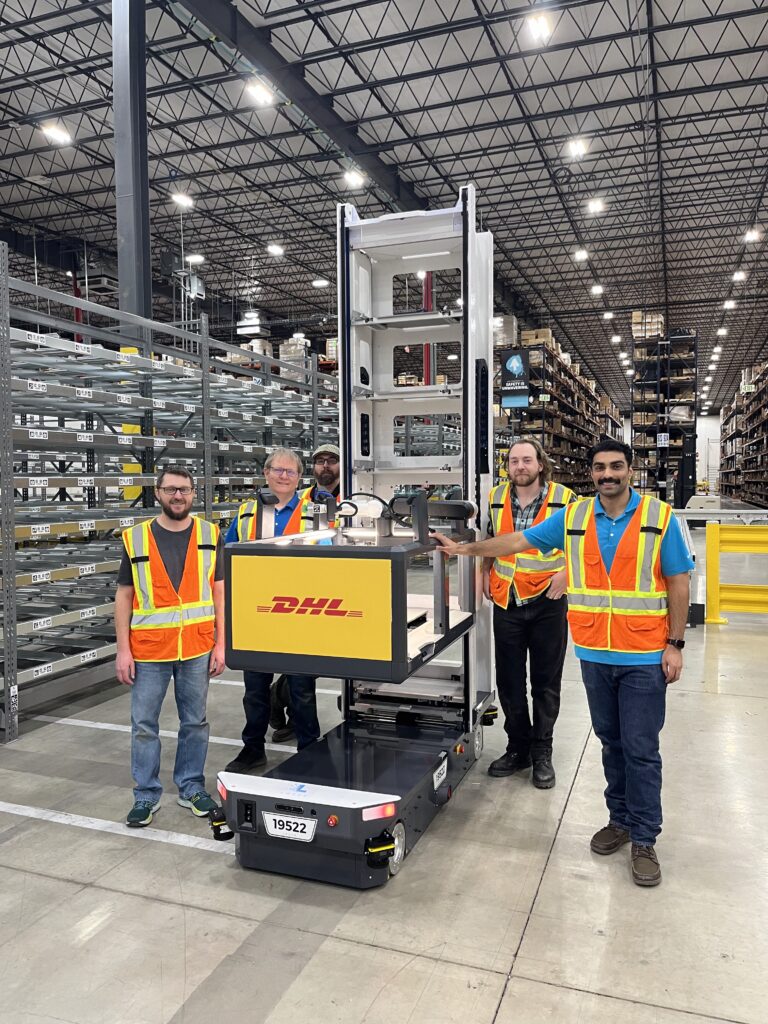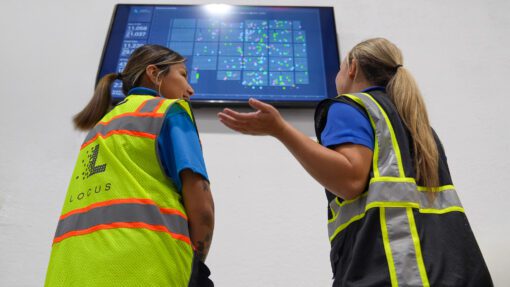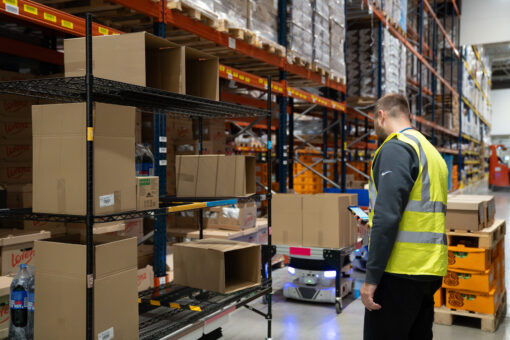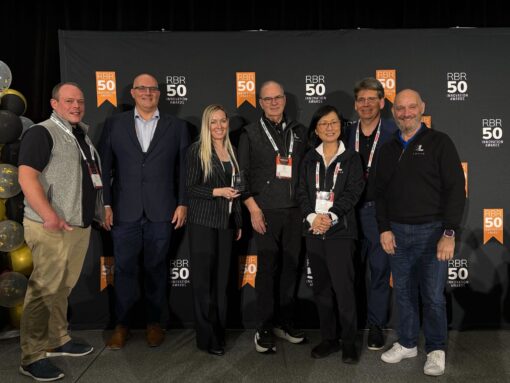WP: How to achieve 400 UPH with Locus Fast Pick
WP: How to achieve 400 UPH with Locus Fast Pick Download Now!
The Dawn of Robots-to-Goods: Locus Robotics Ships its First Array Units to DHL
Rick Faulk, Chief Executive Officer

Today marks one of the most exciting milestones in Locus Robotics’ history — our first Locus Array units arrived at a DHL facility in Columbus, OH.
DHL has been an early and deeply strategic partner for Locus, consistently pushing the boundaries of what’s possible in warehouse automation. Few companies in the global supply chain match DHL’s relentless commitment to innovation — they’re constantly exploring new technologies that deliver greater efficiency, flexibility, and value for their customers.
That’s why it’s especially exciting that DHL will be the first to deploy our new Locus Array units. Their focus on operational excellence and continuous improvement makes them the ideal launch partner for a technology designed to redefine what’s achievable in warehouse productivity.
Sally Miller, Global Chief Information Officer at DHL, said, "At DHL Supply Chain, we don’t just test ideas — we scale innovation globally. Thousands of Locus Origin robots are already transforming our operations worldwide. Now, we’re proud to be the first to deploy Locus Array. This marks the next chapter in autonomous picking and replenishment, and together with Locus, we’re ready to make it a success story."
This moment has been years in the making. It’s been a multi-year journey of reimagining what warehouse automation could be. Along the way, we became the leader in Person-to-Goods (P2G) solutions and are now defining an entirely new category of automation: Robots-to-Goods (R2G).
Defining a New Category: Robots-to-Goods (R2G)
For years, warehouse automation has largely fallen into three camps: Automated Storage and Retrieval Systems (AS/RS), Goods-to-Person (G2P), and P2G. Each has delivered value, but all share limitations.
AS/RS and G2P solutions require significant upfront capital, long deployment times, and fixed infrastructure that limits flexibility as product mixes or order profiles change. They also rely heavily on human labor at the pick station, which limits productivity and introduces variability.
While P2G has been a significant breakthrough — offering tremendous cost advantages, flexibility, and scalability to solve many issues of AS/RS and G2P — there is still a human labor component, with people needed for picking and replenishment tasks.
R2G changes this equation. With Locus Array, robots autonomously pick, move, and replenish inventory to perform tasks that used to require multiple human touches. Locus Array represents the convergence of Agentic AI (digital reasoning and orchestration) and Physical AI (real-world perception and execution). Together, they create systems that sense, decide, and act as one to seamlessly connect digital intelligence with physical action.
The Seven Customer Requirements That Defined Locus Array
As we envisioned Locus Array, we started with a straightforward principle to listen to our customers. With that as input, product management, design, and engineering teams began with seven demanding requirements — and I’m proud to say that Array delivers on every one of them:
- 1. Eliminate 90%+ of Labor While Improving Safety – Locus Array automates nearly the entire picking and replenishment process, removing over 90% of manual touches while virtually eliminating the ergonomic and travel risks for humans found in traditional workflows.
- 2. Superior ROI & Lowest Cost per Pick – Locus Array achieves the lowest cost per pick and fastest payback period of any warehouse automation system in the market to deliver unmatched return on investment (ROI) and long-term operating leverage.
- 3. Global Scalability Across Any Facility Type – Designed to scale effortlessly from small to mega-scale sites, Locus Array can be deployed in both brownfield and greenfield environments with low-cost infrastructure changes. CE certification is underway in preparation for future deployments across EMEA and APAC.
- 4. Predictable, Machine-Like Performance – Locus Array delivers consistent, forecastable high throughput that’s immune to labor variability and ensures dependable performance shift after shift. Eventually, Locus Array will automatically reslot inventory for maximum performance.
- 5. Flexible & Extensible at Scale – Locus Array expands easily across zones, shifts, and sites — without costly reconfiguration — and adapts dynamically to changing volumes, workflows, and product mixes.
- 6. Comprehensive SKU Coverage & High-Density Operation – Locus Array picks a wide range of SKUs across shapes, sizes, and packaging types while increasing storage density and reducing real-estate requirements. It also works in harmony with Locus Origin and Locus Vector to cover 100% of the SKU profile.
- 7. Continuous, Error-Free 24×7 Operation, Including Off-Shift Performance – Locus Array operates continuously across all three shifts, maintaining consistent productivity and accuracy. Locus Array delivers complete operational continuity — including off-shift hours — with no downtime or performance degradation (other than charging).
By listening to our customers, Locus Array was designed to deliver outcomes that matter most to operators — performance, predictability, and profitability.
Agentic + Physical AI: Intelligence That Senses, Decides, and Acts as One
At the heart of Locus Array — and every Locus deployment — is LocusONE™, our unified orchestration platform that brings together two powerful forms of intelligence: Agentic AI and Physical AI.
Agentic AI provides the digital brainpower that reasons, plans, and decides to continuously optimize workflows, sequence missions, and dynamically advise on real-time conditions on the floor. It ensures that every robot, task, and associate operates as part of a coordinated, system-wide strategy.
Physical AI delivers the muscle and perception that brings those digital decisions to life. It sees, navigates, and grasps with precision to enable robots to perform tasks safely, consistently, and autonomously in real-world warehouse environments.
Together, these two forms of intelligence create a self-optimizing, continuously learning ecosystem — one that turns data into decisions, and decisions into action.
For customers, that means:
- Higher throughput from more intelligent workflows.
- Lower cost per order through AI-driven optimization.
- Greater reliability and uptime, even as operations scale.
- Continuous improvement — as the system learns from every pick, route, and grasp to get smarter over time.
This fusion of Agentic and Physical AI is what makes Locus Array more than a robot — it’s an intelligent system that senses, decides, and acts as one.
The Data-Compounding Flywheel for Throughput
Locus Array isn’t just a robot — it’s a continuously learning system. Every pick, every grasp, and every route generates intelligence that improves future performance.
This is the Physical AI Flywheel — a data-compounding loop that drives ever-higher productivity:
- Smarter algorithms in slotting, picking, grasping, tasking, and routing continuously learn from real-world telemetry.
- These insights produce higher UPH and tighter variance, improving SLA reliability.
- More deployments mean more picks — feeding the learning loop and accelerating intelligence.
In plain English: more data → smarter AI → higher throughput → lower cost → more adoption → even more data.
That’s the power of Physical AI.
Why Locus Robotics Wins
People often ask me why Locus Robotics has become one of the largest and fastest-growing robotics companies in the world.
The answer is simple: we listen.
We listen to our customers, their challenges, and their ambitions. Then we deliver — through a team of the most talented people in the industry who know how to turn insight into impact.
Array is the latest expression of that philosophy. It doesn’t just automate work — it redefines what’s possible in warehouse fulfillment.
And today, that future officially begins.
See Locus Array in Action
We’d love to see you in person and demonstrate Array Iive. Join us at:
- LogiMAT 2026, March 24-26, 2026, Messe Stuttgart, Stuttgart, Germany.
- MODEX 2026, April 13-16, 2026, Georgia World Congress Center, Atlanta, GA, USA.
Stop by our booth, see how Locus Array transforms fulfillment, and let’s talk about what we can build together.
A Big Thank You
As we ship our first Locus Array units, I want to take a moment to thank everyone who helped make this milestone possible — both our current team and past Locus Robotics employees, and our remarkable customers who’ve been part of this journey.
From the earliest products and deployments more than 10 years ago, every person and customer has left a mark on what Locus Robotics has become. Locus Array stands as a testament to your innovation, persistence, and belief in what’s possible when brilliant minds come together around a bold idea.
This milestone belongs to all of you — and it’s only the beginning!
Rick Faulk
CEO, Locus Robotics
About the Author
Rick leads the executive team with over 30 years of experience in executive management, sales, and marketing for some of the world’s most successful technology companies, such as Cisco, Intronis, j2 Global, WebEx, Intranets.com, Barracuda Networks, Lotus Development, Mzinga, and PictureTel. Rick leads the executive team and is responsible for the overall strategy and execution at Locus Robotics. Rick currently sits on various boards and is an advisor to multiple companies, including Retrocausal, Arccos, Cybernetix Ventures, and Leading Edge Ventures. Past board positions include Yodle, Virtual Computer, Bidding for Good, Skill Survey, Influitive, Ntirety, Blue Raven, and Centive.




